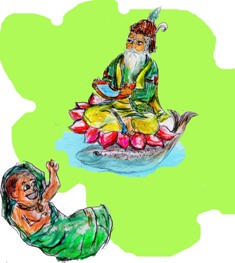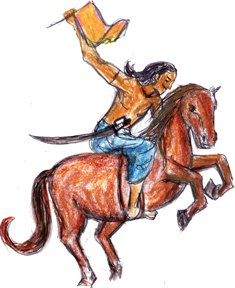Story & Trivia
The Indus geographically separated the Indian sub continent from the Iranian plains. Most conquerors in ancient times crossed this river to get to India. Though this river is called Sindhu in India, it was called the Indus by Westerners.
In the plains of Pakistan, the five rivers of Punjab (Ravi, Beas, Sutlej, Chenab and Jhelum), Kabul from Afghanistan and the Indus are together called the Sapta-Sindhu or the Seven Sindhus. Occasionally the river which disappeared, Saraswathi, is included and Kabul is dropped.
As this was an extremely fertile and well irrigated area, it often interested many conquerors. In the 10th century AD Mirkshah ruled Thatta. He was a tyrant who was easily swayed by the people surrounding him. He once called the ‘panch’, representatives of local Sindhis who were Hindus and ordered them to convert to Islam or accept death. The Sindhis begged for lenience and were given forty days.
The Sindhis begged Varuna the God of Water to come to their aid. For forty days, all of them did penance. They prayed, fasted, sang songs in praise of Lord Varuna, grew their hair and wore no new clothes. After forty days, the Lord was pleased. A voice from the heavens declared that he would save them from the tyrant Mirkshah, by taking birth as a mortal in Mata Devki’s womb. Mata Devki lived at Ratanchand Lohano’s house in Nasarpur.
This day is remembered every year as ‘Thanksgiving Day’ and it comes after 40 days of fasting. After three months, to the Sindhis great joy they heard that Mata Devki would soon be having a baby. One day, unseasonal dark clouds gathered and torrential rains poured. Like a ray of happiness in this dark atmosphere, Mata Devki’s baby was born. A miracle happened – the baby opened its mouth and a vision of the Sindhu flowing, with an old man sitting cross-legged on a pala-fish was seen.
After three months, to the Sindhis great joy they heard that Mata Devki would soon be having a baby. One day, unseasonal dark clouds gathered and torrential rains poured. Like a ray of happiness in this dark atmosphere, Mata Devki’s baby was born. A miracle happened – the baby opened its mouth and a vision of the Sindhu flowing, with an old man sitting cross-legged on a pala-fish was seen.
The pala-fish was found locally, tasted good and swam against the current. The baby was named Udaichand and was also called Uderolal. Residents of Nasarpur called him Amarlal. Funnily the cradle in which the baby slept would sway to and fro on its own and from this came the very famous name ‘Jhulelal’.
Mata Devki passed away and Ratanchand married again. Soon, Mirkshah called the ‘Panch’ again and asked them for their decision. He had heard about the birth of the child and so had the people who gave him bad advice. Confident now, the ‘panch’ asked for more time. Mirkshah was very amused by the very thought of a child defeating him is some way. He allowed them time against the advice he got, but he did ask his minister Ahirio to give him a first hand account of things in Nasarpur.
Ahirio was a cautious man and so though he expected no trouble from a baby, he did take along a rose dipped in poison. The child bedazzled him. When offered the flower, the child blew it at his feet in one puff of breath. And then the unimaginable happened – the baby changed into an old man with a flowing white beard, then the image morphed to that of a young sixteen year old boy and soon it was Uderolal with a blazing sword in his hand and a column of warriors behind him.
Ahirio knew he had seen the Sindhu Lord. He returned and narrated the magical happenings to Mirkshah. But the tyrant declared Ahirio had been taken in by simple magic. Heart of hearts he was a little scared.
To make things worse he dreamt that night that a child was sitting on his neck. Just as it happened to Ahirio, the vision morphed into an old man with a beard, then into a young boy and then the warrior like Uderolal. The following day Mirkshah called Ahirio and asked him to counter the threat. But Ahirio asked Mirkshah to be cautious.
In the meantime Uderolal was growing up. He received the Guru mantra. To make ends meet, his step-mother would ask him to see the baked beans in the marketplace. But, Uderolal just went to the banks of the Sindhu. He threw half into the river and the other half he distributed among the needy. Then he would spend his time speaking of spiritual matters with people of the banks. On his way home in the evenings, he would fish out a container full of fine quality rice from the river!
After his father Ratanchand watched this miracle, he knew Uderolal was the saviour. Mirkshah’s advisers pushed him to get the Hindus to covert to Islam. But now, Mirkshah knew it would be wrong to force people to do something against their will. To solve his problem, he asked Ahirio to arrange a meeting with Uderolal.
Ahirio by now was a devotee of Daryashah  (King of rivers), another name of Uderolal’s. He went to the banks and pleaded with the water god to come to his rescue. A man on a pala-fish with a flowing white beard appeared. Ahirio realized that the revered Khwaja Khizr and Uderolal were the same. He watched in amazement as Uderolal jumped on to a horse and galloped off with a sword in one hand a flag in the other.
(King of rivers), another name of Uderolal’s. He went to the banks and pleaded with the water god to come to his rescue. A man on a pala-fish with a flowing white beard appeared. Ahirio realized that the revered Khwaja Khizr and Uderolal were the same. He watched in amazement as Uderolal jumped on to a horse and galloped off with a sword in one hand a flag in the other.
He went up to Mirkshah and explained that all creation was one God’s. It so happened, that Mirkshah called him Allah, while others called him by other names. But the ill advised Mirkshah ordered his soldiers to arrest Uderolal.
When they tried, great waves of waters rose from nowhere. Fires broke out in the Palace. Fear of drowning was great. Again Uderolal explained to Mirkshah that all Gods were the same. He asked him not to persecute the Sindhis based on religion.
Mirkshah understood now how foolish he had been. He begged Uderolal to save his courtiers. Uderolal nodded and soon the floods receded and the fires died. All were safe. Mirkshah agreed not to differentiate his treatment on the basis of religion.
Uderolal asked the Hindus to build a temple in memory of Mirkshah’s transformation. He suggested a fire be kept lighted everyday and water be made available for a ‘holy sip’. Uderolal named his cousin as the first head of the religious sect which believes in the Water God. Seven symbolic things were given to him. These are very important to these followers who were called the Daryahi. Soon Uderolal gave up his earthly avatar and left for the place he had come from.
A ‘qaba’ was to be built by the Muslim followers and the Hindu followers wanted to build a ‘samadhi’. As they debated and fought, rains poured and a voice from the heavens said: Make a shrine acceptable to both Hindus and Muslims. One face like that of a temple and another like a dargah’s: I belong to all of you.
Ever since then for a Sindhi, irrespective of the religious affiliation, the greeting always has been “Jhulelal – Bera Hee paar”, which roughly translates to “Jhulelal-obstacles have been crossed”. Jhulelal epitomizing Lord Sindhu or Varuna, goes to show the unifying spirit of water.
Indus Valley Civilizations
The river has been a cradle to great civilizations – Harappa and Mohenjodaro. In the 1850s the British constructed the Lahore-Multan railroad. Bricks were easily available in the local villages. As bricks were taken away they realized that they had been using bricks from a huge ancient buried city-Harappa. Eventually Mohenjadaro too was excavated.
These were fine studies in city design with well laid out streets, plumbing, sewers, and indoor toilets. They had a script, industry and even traded peaceably. All this glory faded about 3800 years ago, leaving behind no clues.
Trivia
1. The Indus is the longest river in Pakistan.
2. It is essential to the economy and people of Pakistan to the extent that it is considered the life-line of Pakistan.
3. The Indus River is home to the Indus River Dolphin, similar to the Ganges River Dolphin in the way that its eyesight is very bad. The Indus River Dolphin swims on its side meaning that it can swim in very shallow waters.
4. The river’s height is determined by the seasons; the rains of the monsoon enable high flow in those months while the water diminishes greatly in the winter.
5. The primary source of the Indus is Tibet.
6. Some of the first civilizations in the world were built along the banks of the Indus.
7. The river is also fed by the Himalays, the Karakoram, and the Hindu Kush.
8. Rainfall in the Indus Valley is low, so farming and everyday water reserves rely heavily on the river’s waters.
9. The Indus has an extensive irrigation system dating back to the first times irrigation was used in ancient civilizations.
10. There are major conflicts between India and Pakistan over the waters of the Indus.
/articles/indus-river